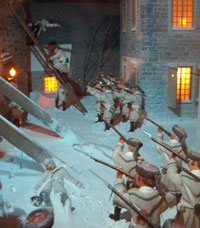|
 Revolution Rejected:
Canada and the American Revolution, curated by staff
historian Peter MacLeod, uses artifacts, a scale-model diorama,
audio-visual material, maps, images and personal accounts to
tell the story of the American invasion of Canada in
1775–1776 and the migration of American Loyalists to
Canada after 1783. Revolution Rejected:
Canada and the American Revolution, curated by staff
historian Peter MacLeod, uses artifacts, a scale-model diorama,
audio-visual material, maps, images and personal accounts to
tell the story of the American invasion of Canada in
1775–1776 and the migration of American Loyalists to
Canada after 1783.
When the American Revolution
broke out in 1775, George Washington sent two armies north to
besiege Quebec City and conquer Canada. In the early morning of
December 31, American generals Richard Montgomery and Benedict
Arnold launched a desperate assault on Quebec.
In Revolution
Rejected, a detailed diorama freezes the action at a
crucial moment in Canadian history. Montgomery has been killed
and Arnold wounded, but Arnold's troops have fought their way
into Quebec's Lower Town. They begin to scale the barricade that
forms Lower Town's last line of defence.
Behind the barricade, British
regulars and French- and English-speaking militia form up to
meet them. The Americans break into a house that overlooks the
barricade and open fire on the defenders; Canadian militia and
British regulars charge up a ladder into a second-story window
of the closest house.
 As visitors observe the action, they hear the
shrieking wind of a vicious blizzard, loud shouts, volleys
of musketry and boots crunching on snow. A narrator
provides a brief commentary, as resolute defenders overcome
the invaders. Off to one side, tiny figures on a unique,
beautifully carved powder horn commemorate Arnold's march
to Quebec and the dramatic night attack. As visitors observe the action, they hear the
shrieking wind of a vicious blizzard, loud shouts, volleys
of musketry and boots crunching on snow. A narrator
provides a brief commentary, as resolute defenders overcome
the invaders. Off to one side, tiny figures on a unique,
beautifully carved powder horn commemorate Arnold's march
to Quebec and the dramatic night attack.
Revolution Rejected
then shifts its attention from the clash of armies in the
streets of Quebec to the impact of a great war on one young
girl. Born in the British colony of New York, Hannah Ingraham
was three years old when the revolution began in 1775, eleven
when it ended in 1783. Her parents were Loyalists —
Americans who supported the British. Trapped behind American
lines, Hannah watched as local rebels confiscated the Ingraham
farm and her father escaped to serve with a Loyalist regiment.
When the war ended, her family became refugees who built new
lives in what is now New Brunswick.
In the mid-nineteenth century,
Hannah dictated her reminiscences to a neighbour. Extracts from
this powerful memoir in Revolution Rejected let
visitors experience the war through the eyes of a frightened
child. A photograph of an elderly Hannah lets them look into the
eyes of a woman who survived the American Revolution and
personifies the human consequences of the war.
Visitors will also notice the
blazing scarlet of a British provincial uniform, worn by Loyalist Jeremiah
French during the later years of the war. This is one of the
oldest complete uniforms in Canada, and the oldest in the
Canadian War Museum collection.
The American Revolution is
one of Canada's least-known, most important wars. For most
Canadians, the revolution is something that happened somewhere
else, south of the border. Yet without the events portrayed in
Revolution Rejected, the Canada we know today might not
exist. The Canadian victory at the siege of Quebec in
1775–1776 saved Canada from conquest and incorporation
into the new United States. Loyalist refugees added a
significant English-speaking element to the population and led
to the creation of the provinces of Upper Canada (Ontario) and
New Brunswick. In 1867, the British colonies that rejected the
American Revolution came together to form the Dominion of
Canada.
|